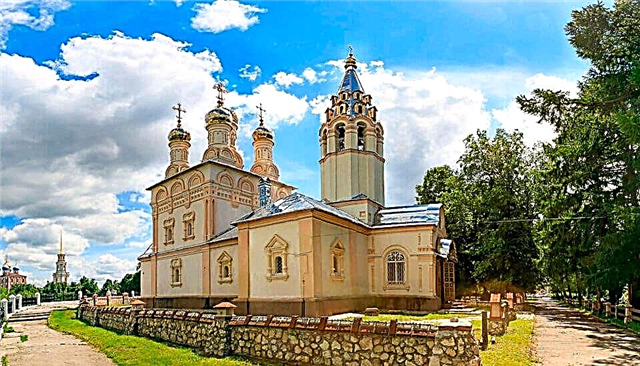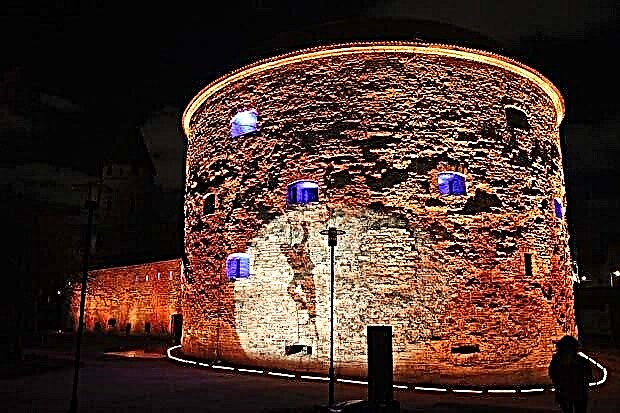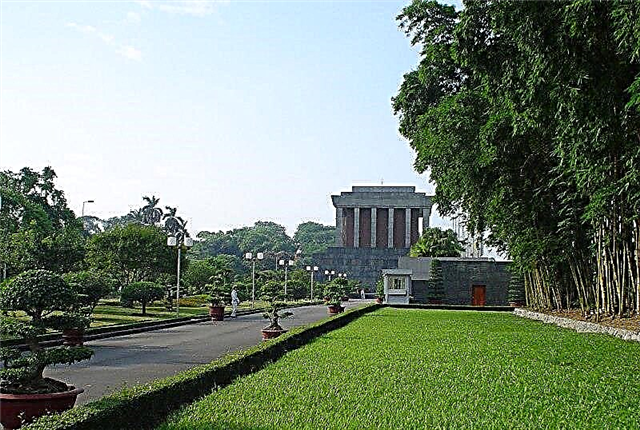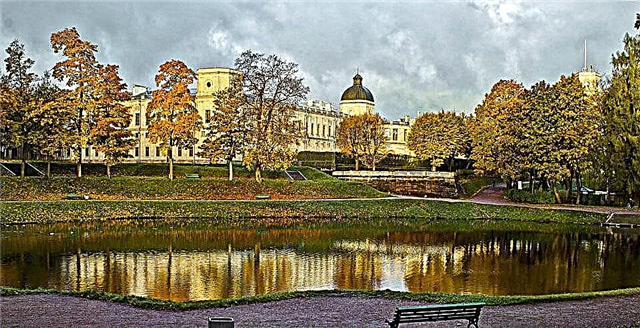Museum-Reserve of Gatchina - Suburban Hermitage or the Castle of Russian Hamlet. Such names were given to the complex at the beginning of the 20th century. The palace at various times was the estate of a nobleman and the residence of the Romanov family. It was in its prime and decline, was loved and was in oblivion, was built and lay in ruins. And today the center is experiencing a rebirth. The restoration of the Grand Palace and the park has been completed. Unforgettable hours spent on the territory of the reserve await guests.
History

In the scribes, the first mention of Gatchina is found in the 15th century. Then these lands belonged to Novgorod. Then they were handed over to the Swedish king, who owned them until 1702. Peter's victory in the Northern War ensured the return of lands to the Russian crown. In 1765 Gatchina was donated by Empress Catherine II to Grigory Orlov.
He began building the palace almost a year later. The project was created by Rinaldi. At the request of the owner, the building was supposed to resemble an English castle. Initially, the building had 3 floors and a square shape. The building was connected to the Silver Lake by an underground passage. The palace was crowned with 10 towers, and the facades were finished with local (Gatchina) limestone.
Gatchina after the death of Grigory Orlov

Grigory Orlov died in 1783, and Gatchina returned to the ownership of the royal family. Now its owner is the future emperor Paul I. He is not satisfied with the palace, and the Grand Duke begins perestroika. Architect Brenna was invited to carry out this task.
Now the ensemble is changing:
- The galleries become closed, the walls of the square are completed to the level of the galleries.
- The yard was transformed into a parade ground. A moat was dug on it, bridges were built and cannons were installed.
Such changes lead to the fact that the building becomes identical to the English castles. Since 1801, Gatchina has been owned by the Dowager Empress Maria Feodorovna. During this period, Voronikhin rebuilds the palace again, but the changes mainly affected the interiors. Significant changes awaited the palace during the reign of Nicholas I.
Guest Architect Kuzmin:
- rebuilt the square
- increased the towers of the buildings by an entire floor
- re-tiled the walls of the facades
- built a church in the side square
- finished the apartments for the owners in the Arsenal square
- added a central staircase
- installed a statue of Paul I
Alexander III was a supporter of technical innovations: he introduced heaters instead of stoves, equipped the palace with water supply and sewerage systems.
Gatchina after the October Revolution

After the revolution, the complex became the largest museum in the region. His collection contained priceless artifacts, and everyone could see them. Thematic exhibitions were held in specially designated buildings. The advance of the German troops to the east was too fast, the employees of Gatchina did not have time to carry out a complete evacuation of the artifacts: they saved the main funds and the archive.
In January 1944, during the retreat, the Nazis almost completely destroyed the Grand Palace. In the surviving buildings after World War II, the Naval School and the All-Russian Research Institute of Elektrostandart were alternately located. The restoration of the damaged buildings began in the 60s, and the first visitors saw the exposition only in 1985.
What to watch

The complex consists of several thematically related structures:
- Of the Great Palace. The historic building is surrounded by a park, which itself is a unique exhibition of landscape design. The humpback bridge is especially popular with tourists. Great photos are taken here.
- Priory Palace. The freestanding building is also surrounded by an unusual park.
- St Paul's Cathedral. It was built in the Byzantine style. The temple is a cultural heritage of Russia.
- Intercession Cathedral. This is a significant church for all Orthodox Christians.
On the territory of the former estate of Grigory Orlov, there are small, but interesting exhibitions that should be seen: Own Garden, Signal Tower, Venus Pavilion, Birch House.
Gatchina palace

The Grand Palace is the pearl of the reserve. It is located in the suburbs of St. Petersburg. Currently, the restoration, which began in the 60s of the last century, is completed, and the complex is receiving visitors. The interiors have been completely restored. The surviving watercolors from different years helped in the work.
The castle of Russian Hamlet consists of 3 main parts:
- central building of 3 floors with 2 towers
- Kitchen square
- Stable square
The center has permanent exhibitions: weapons, furniture, items that were used by members of the royal family at different times. In addition, the administration offers to visit thematic exhibitions and lectures. By prior arrangement, guests can come to the ball, which takes place in the palace. They will be greeted by Paul I with his wife, Maria Feodorovna. Poetry and musical evenings and concerts are held in the historical premises. Information and 3D technologies are used during the events. We can say that today the Suburban Hermitage is living an active life. The Grand Palace is included in the list of UNESCO sites.
Priory Palace

At the end of the 18th century, Emperor Pavel Petrovich was actually the Grand Master of the Order of Malta. And he built the palace as his own residence, in which the knights who came to Russia could stay. The architect Lvov chose the location of the mansion with significance: it seems that a light building is growing out of the Black Lake. The red roof and tower are beautifully reflected in the water. All together creates the illusion that there is a Catholic monastery on the shore.
The building is not high: only 2 floors. And at the bottom, the width of the walls is 13 cm wider than at the top. As a support, the architect used a masonry of Pudost stone (strong and frost-resistant, which was mined near Gatchina). So Lvov ensured the stability of the structure. After the death of Pavel Petrovich, Emperor Alexander I, who became the successor of the Grand Master, returned the Priory Palace to the treasury. For some time there was a Lutheran church. Later, the royal residence was modernized: a sewage system was installed, steam heating was installed. Before the revolution, a retinue was located here.
After the October Revolution, the palace was converted into a recreation center for Leningrad workers. After the war (and the building practically did not suffer from the bombing, Lviv was building for centuries), the house of pioneers, a military unit, and a local history museum were located here. In the 80s, it was decided to carry out a large-scale restoration, which ended in 2004. From that moment on, the palace again receives guests.
Palace park

The park was laid out during the time of the first owner of Gatchina, Grigory Orlov. Special attention was paid to its layout. The territory was divided into sections with viewing platforms and small pavilions. In the park, a quarter of the area is occupied by water: 2 lakes, rivers, ponds, canals. Today they have been cleared and landscaped. Here you can go boating, feed carp. And in the park, tame squirrels come up to people and eat nuts and seeds from the palm of their hand.
Gatchina Park is divided into zones:
- English garden. This territory unites Serebryanoe and Beloe lakes, the islands of Pikhtovy, Zakharov and Dlinny. This part of the park houses the Birch House, the Pavilion and Column of the Eagle, the Humpbacked Bridge.
- Its own garden is adjacent to the Gatchina Palace. In this part, green covered alleys are noteworthy, the supporting parts of which have balustrades. There are sculptures here.
- The Lower Dutch Garden is adjacent to the Upper. They are distinguished by picturesque alleys.
- The Linden Garden has paths and lawns. It adjoins the Upper Garden.
- There are ponds in the Upper and Lower Botanical Gardens. Each of the gardens has a pharmacy garden and a flower slide.
- The alleys of the Forest Labyrinth converge at one point, from which a view of the Water Labyrinth opens (a system of 4 islands with channels and straits).
- Love Island is a garden located on the artificial island of the White Lake. Here you can visit the Pavilion of Venus.
In the gardens, the paths are paved with tiles, the steps of the stairs connecting the upper and lower parts of the park are made of granite. The alleys are well-groomed and cleaned: it is pleasant to walk here. But the park became accessible to everyone only after the October Revolution. Until 1917, only the imperial family walked in it.
Collections

The complex provides an opportunity to get acquainted with an extensive collection of artifacts:
- Sculptures and stone products. This exhibition includes marble busts, medallions of foreign statesmen and members of the Russian imperial family.
- Lithographs and engravings. The number of exhibits exceeds 600 items. The works of Utkin, Chemesov, Wortman, James, Klauber are presented.
- Metal products. Guests will see a clock, bronze candlesticks.
- Furniture items. At the time of the Romanovs, the palace had 25,000 unique items. The main part of the collection has been lost or plundered, so now only 25 can be seen.
- Weapons. Even Grigory Orlov began collecting artifacts. This tradition was continued by all the owners of the palace.
- Fabrics and costumes. Much of it was lost during the Second World War. Today, guests will see unique tapestries and embroideries.
- Numismatics. This is a small exposition, the owners of Gatchina were not engaged in systemic collecting.
- Drawings. This part of the collection was evacuated in 1941, it has been completely preserved. This made it possible to restore the palace with maximum precision.
- Household collection. It is based on inkpots, ashtrays, and boxes. The main part was lost from 1941 to 1944.
- Decorative and applied arts. These are the products of the porcelain factories of Russia, which were used by the Romanovs.
- Photos. The collection was based on photographs of the family members of the last Romanov. But even after the coup, the collection was replenished.
- Archive. This part of the exhibition was evacuated and fully preserved. Here you will find information, documents, plans related to the estate.
- Watercolors and drawings. Today, guests will see over 500 perfectly preserved units.
It is clear that it is impossible to present all the artifacts for inspection at the same time. The administration periodically updates the permanent exhibitions, organizes thematic ones.
Interesting Facts

The reserve is surrounded by legends. Each building is fraught with events that accompanied its construction.
The beginning of adobe construction in Russia
Emperor Pavel Petrovich, in a conversation with the Russian Leonardo da Vinci, the architect Lvov, said that he had seen houses in Europe being built from a mixture of earth, lime and sand. And these buildings are pretty sturdy. The tsar ordered the architect to build a corner of a hut with a roof in Gatchina using the same technology.
Lvov ordered two men and began to erect the building. Pavel Petrovich regularly came with his son Alexander and daughter-in-law to watch how the business was progressing. Once the crown princess tried to dig a hole in the wall with the sharp end of an umbrella. She did not succeed: thus, the strength of the prototype was proved. Today the Priory Palace is the only building in Russia built using the technology of earth-pit construction.
How the site was chosen for the Priory Palace

Emperor Pavel Petrovich, after the approval of the plan presented by Lvov, instructed the architect to choose a place for the Priory Palace at his own discretion. But Obolyaninov, who at that time managed the park, denied all the places indicated by the architect. In the end, Lvov said that he would build a building where the capricious general indicated.
Obolyaninov singled out a place so swampy that a dog got stuck. But Lvov said that he would build a palace here too, but the estimate would be too high, because the swamp would have to be drained. Obolyaninov resigned himself and allowed the architect to choose the place himself. As a result, the construction cost Pavel Petrovich 27,000 rubles, of which the actual construction of the palace and walls from the earth cost 2,000 rubles, and the remaining 25,000 were spent on stone construction, roofing, joinery and carpentry work.
The symbol of Gatchina

The eagle is the symbol of the palace and park ensemble. According to legend, Emperor Pavel Petrovich shot an eagle with a gun. A proud bird fell to the ground in the park. In this place, the emperor ordered to build a column, and in the place where he was standing at the time of the shot - a pavilion. But there is some understatement here: the pavilion was built under Pavel Petrovich, and the column - under the first owner, Grigory Orlov. But the fact that the pavilion depicts an eagle holding the monogram of Paul in its paws is obvious. And why two structures erected at different times make up an ensemble, it is impossible to say for sure.
Echo grotto

The underground passage from the palace ends on the shore of Lake Beloe. And it is stylized as a grotto. But the architectural features of the building make it possible for an echo to appear from several syllables. For example, if you shout into the tunnel: who did not rule for long, then the echo returns the answer: Paul.
The Mystery of Kerensky's Escape

Kerensky in his memoirs describes his escape from the Gatchina Palace in 1917 through an underground passage. In these difficult days, soldiers and sailors occupied the only exit from the royal residence. After waiting for darkness, the politician went out through the dungeon. But he does not specify whether through the move that ends in the grotto of Echo, or through some other.
Visiting rules

In order for the excursion to leave only pleasant impressions, you should follow the recommendations:
- purchase tickets at the box office that you want to keep until the end of the tour
- it is forbidden to bring prohibited items into the territory (weapons, glass, breakable objects, drugs, explosives)
- it is forbidden to visit the center in a state of intoxication
- large-sized bags (more than 20x30 cm) should be left in the storage room
- it is forbidden to disturb the silence and disturb other visitors
- it is forbidden to come to the center with animals and transport strollers
- it is forbidden to use the flash when taking pictures without the permission of the administration
- when entering the halls, it is required to put on safety shoes, and leave outerwear in the wardrobe
It is recommended to choose excursions according to your own tastes and preferences.
Opening hours and ticket prices

The Gatchina reserve receives guests every day from 10 am to 6 pm. It is important to remember: you can buy tickets until 5 pm. An adult ticket costs 400 rubles (during the Christmas holidays - 500 rubles). For students, a visit will cost 200 rubles. Seniors (over 65) will also pay 200 rubles. A family pass is offered: 2 adults and children - 1000 rubles. The bearer of the St. Petersburg Guest Card inspects the museum free of charge (during the entire validity period of the document).
Tours

Gatchina is a great place for an independent exploration. But, of course, guided walks will leave more vivid impressions:
- The castle of Russian Hamlet will amaze tourists. An unusual layout, colorful interiors, a combination of knightly traditions with the homeliness of the Romanov family, the guide's story about the ghosts of the underground passage that also live in the castle, will make time fly by.
- You can study the history of the Romanov family from the history of the Gatchina Palace. Inspection of the Prirat castle will reveal the secrets of the Masonic movement in Russia (Pavel Petrovich was also the master of the Order), a visit to the Island of Love and the Venus pavilion will add a romantic touch to the tour.
- It is impossible to get an idea of the Suburban Hermitage without walking through the unique park with its shady alleys. Guests must take a walk with a guide after visiting the exposition of the Grand Palace. And the stories told by the guide will leave an unforgettable experience.
The guest service includes a transfer from the city of St. Petersburg. But booking a place is required in advance.
Where is it located and how to get there

The reserve is located at the address: Krasnoarmeisky Prospekt 1, Leningrad Region, the city of Gatchina. It's easy to get here:
- on a rented car along the Kiev highway (using a navigator)
- by bus 431 or fixed-route taxis 18, 18A (in St. Petersburg they stop at the Moskovskaya metro station)
- by train from the Baltic station
It remains to walk a few minutes from the stop to the complex.











